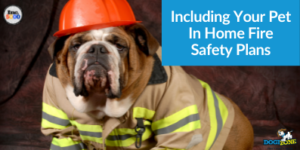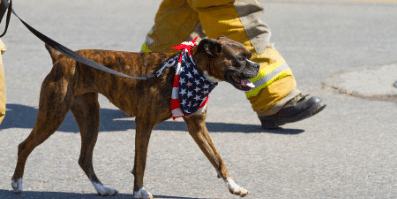Including Your Pet In Home Fire Safety Plans
Every family should have a pet fire safety plan. This is a plan that ensures everyone in the family knows what to do and where to go in the event of a fire or another type of dangerous situation in the home or residence. Often overlooked in the development of a fire plan is the protection and safety of a pet in the home. 
Pet Fire Safety Plan
It is important to have designed people in charge of the pets in your home. Ideally, responsible older children or adults should have this role. Dogs can be easily frightened and hide if there is a fire or other situation, and it is essential any child with this role understands they need to be concerned about their safety and not stay in an unsafe situation to try to find a pet.
Keep leashes or carriers in the same location near exits. The person designated to find and remove the pet should know where this important equipment is stored and how to access it in an emergency.
When the family practices fire drills, be sure to include the “rescue” of the pet. This helps everyone to understand the pet is being cared for and helps to prevent children from trying to deal with finding or removing a pet in an actual fire emergency.
Consider Potential Risks
Most people think of accidental fires in homes starting with something done by a child or adult. In the United States, approximately 700 fires in homes are actually started by a pet. There are several ways that dogs and cats can start fires in a home, and knowing what they are can help to prevent these issues.
The most common causes of fires started by pets include:
- Candles on tables – candles can be easily knocked over by cats or dogs. Consider switching to LED candles or extinguishing any lit candles if you leave the room.
- Electric room heaters – also known as space heaters, dogs can easily knock them over, resulting in a fire hazard. While most new space heaters have automatic shutoffs if they are not sitting level, turning them off when you leave the room is always the safest option.
- Stoves – any stoves, either electric or gas, with controls on the front can accidentally be turned on by a pet jumping up and hitting the surface. Buy covers for the control knobs or choose a model with the controls on the back of the stove.
- Glass water bowls – while not common, glass water bowls can, with the right angle of the sun, become magnifying glasses. This is most commonly an issue when the bowls are outside on a wooden deck surface. Switch to ceramic, metal, or plastic bowls kept in a shady location.

Notify the Fire Department
If your pets are indoors alone when you are gone, consider adding a sticker to the front back door or windows to provide notice there are pets in the home. Use a sticker that allows you to provide information on pet names, numbers, types, and veterinarian’s information. Stop by DogiZone on July 15 and get your Pet Rescue Window Cling for National Pet Fire Safety Day.
It is also wise to have a pet first aid kit kept outside of the home. This could be in a vehicle, garden shed, or garage. In the event of any injury to the pet, this first aid kit can be accessed without the need to return to the home or carry additional items during the evacuation.

